Sequences, Series and Binomial Theorem
Binomial Theorem
Learning Objectives
By the end of this section, you will be able to:
- Use Pascal’s Triangle to expand a binomial
- Evaluate a binomial coefficient
- Use the Binomial Theorem to expand a binomial
Before you get started, take this readiness quiz.
Use Pascal’s Triangle to Expand a Binomial
In our previous work, we have squared binomials either by using FOIL or by using the Binomial Squares Pattern. We can also say that we expanded ![]()
To expand ![]() we recognize that this is
we recognize that this is ![]() and multiply.
and multiply.
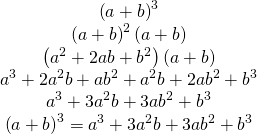
To find a method that is less tedious that will work for higher expansions like ![]() we again look for patterns in some expansions.
we again look for patterns in some expansions.
| Number of terms | First term | Last term | |
|---|---|---|---|
| 2 | |||
| 3 | |||
| 4 | |||
| 5 | |||
| 6 | |||
| n |
Notice the first and last terms show only one variable. Recall that ![]() so we could rewrite the first and last terms to include both variables. For example, we could expand
so we could rewrite the first and last terms to include both variables. For example, we could expand ![]() to show each term with both variables.
to show each term with both variables.

Generally, we don’t show the zero exponents, just as we usually write x rather than 1x.
- The number of terms is

- The first term is
 and the last term is
and the last term is 
- The exponents on a decrease by one on each term going left to right.
- The exponents on b increase by one on each term going left to right.
- The sum of the exponents on any term is n.
Let’s look at an example to highlight the last three patterns.

From the patterns we identified, we see the variables in the expansion of ![]() would be
would be
To find the coefficients of the terms, we write our expansions again focusing on the coefficients. We rewrite the coefficients to the right forming an array of coefficients.

The array to the right is called Pascal’s Triangle. Notice each number in the array is the sum of the two closest numbers in the row above. We can find the next row by starting and ending with one and then adding two adjacent numbers.
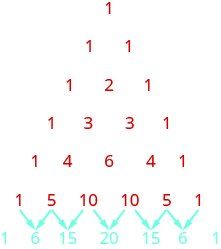
This triangle gives the coefficients of the terms when we expand binomials.
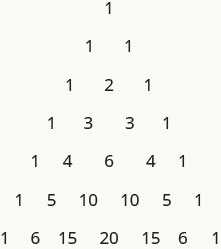
In the next example, we will use this triangle and the patterns we recognized to expand the binomial.
Use Pascal’s Triangle to expand ![]()
We know the variables for this expansion will follow the pattern we identified. The nonzero exponents of x will start at six and decrease to one. The nonzero exponents of y will start at one and increase to six. The sum of the exponents in each term will be six. In our pattern, ![]() and
and ![]()
*** QuickLaTeX cannot compile formula:
\begin{array}{c}{\left(a+b\right)}^{n}={a}^{n}+___{a}^{n-1}{b}^{1}+___{a}^{n-2}{b}^{2}+...+___{a}^{1}{b}^{n-1}+{b}^{n}\hfill \\ {\left(x+y\right)}^{6}={x}^{6}+___{x}^{5}{y}^{1}+___{x}^{4}{y}^{2}+___{x}^{3}{y}^{3}+___{x}^{2}{y}^{4}+___{x}^{1}{y}^{5}+{y}^{6}\hfill \end{array}
*** Error message:
Missing { inserted.
leading text: ...{array}{c}{\left(a+b\right)}^{n}={a}^{n}+__
Missing { inserted.
leading text: ...array}{c}{\left(a+b\right)}^{n}={a}^{n}+___
Missing { inserted.
leading text: ...\right)}^{n}={a}^{n}+___{a}^{n-1}{b}^{1}+__
Missing { inserted.
leading text: ...right)}^{n}={a}^{n}+___{a}^{n-1}{b}^{1}+___
Missing { inserted.
leading text: ...{a}^{n-1}{b}^{1}+___{a}^{n-2}{b}^{2}+...+__
Missing { inserted.
leading text: ...a}^{n-1}{b}^{1}+___{a}^{n-2}{b}^{2}+...+___
Missing } inserted.
leading text: ...2}+...+___{a}^{1}{b}^{n-1}+{b}^{n}\hfill \\
Missing } inserted.
leading text: ...2}+...+___{a}^{1}{b}^{n-1}+{b}^{n}\hfill \\
Missing } inserted.
leading text: ...2}+...+___{a}^{1}{b}^{n-1}+{b}^{n}\hfill \\
Missing } inserted.
leading text: ...2}+...+___{a}^{1}{b}^{n-1}+{b}^{n}\hfill \\
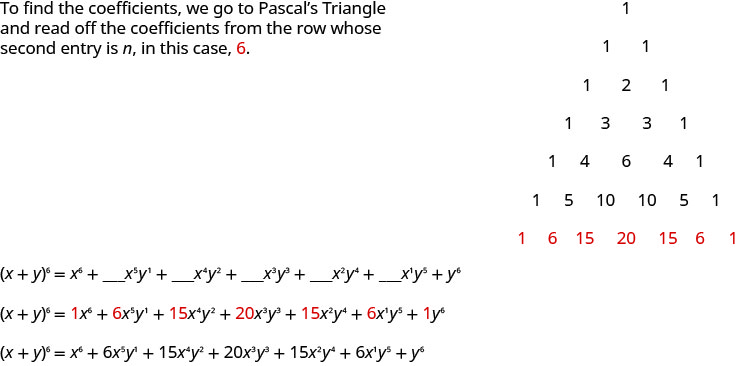
Use Pascal’s Triangle to expand ![]()
![]()
![]()
Use Pascal’s Triangle to expand ![]()
![]()
![]()
In the next example we want to expand a binomial with one variable and one constant. We need to identify the a and b to carefully apply the pattern.
Use Pascal’s Triangle to expand ![]()
We identify the a and b of the pattern.

In our pattern, ![]() and
and ![]()
We know the variables for this expansion will follow the pattern we identified. The sum of the exponents in each term will be five.
*** QuickLaTeX cannot compile formula:
\begin{array}{c}{\left(a+b\right)}^{n}={a}^{n}+___{a}^{n-1}{b}^{1}+___{a}^{n-2}{b}^{2}+...+___{a}^{1}{b}^{n-1}+{b}^{n}\\ {\left(x+3\right)}^{5}={x}^{5}+___{x}^{4}·{3}^{1}+___{x}^{3}·{3}^{2}+___{x}^{2}·{3}^{3}+___{x}^{1}·{3}^{4}+{3}^{5}\end{array}
*** Error message:
Missing { inserted.
leading text: ...{array}{c}{\left(a+b\right)}^{n}={a}^{n}+__
Missing { inserted.
leading text: ...array}{c}{\left(a+b\right)}^{n}={a}^{n}+___
Missing { inserted.
leading text: ...\right)}^{n}={a}^{n}+___{a}^{n-1}{b}^{1}+__
Missing { inserted.
leading text: ...right)}^{n}={a}^{n}+___{a}^{n-1}{b}^{1}+___
Missing { inserted.
leading text: ...{a}^{n-1}{b}^{1}+___{a}^{n-2}{b}^{2}+...+__
Missing { inserted.
leading text: ...a}^{n-1}{b}^{1}+___{a}^{n-2}{b}^{2}+...+___
Missing } inserted.
leading text: ...2}{b}^{2}+...+___{a}^{1}{b}^{n-1}+{b}^{n}\\
Missing } inserted.
leading text: ...2}{b}^{2}+...+___{a}^{1}{b}^{n-1}+{b}^{n}\\
Missing } inserted.
leading text: ...2}{b}^{2}+...+___{a}^{1}{b}^{n-1}+{b}^{n}\\
Missing } inserted.
leading text: ...2}{b}^{2}+...+___{a}^{1}{b}^{n-1}+{b}^{n}\\
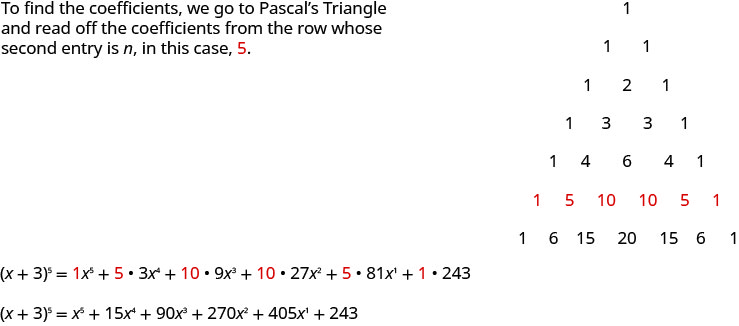
Use Pascal’s Triangle to expand ![]()
![]()
Use Pascal’s Triangle to expand ![]()
![]()
![]()
In the next example, the binomial is a difference and the first term has a constant times the variable. Once we identify the a and b of the pattern, we must once again carefully apply the pattern.
Use Pascal’s Triangle to expand ![]()
We identify the a and b of the pattern.

In our pattern, ![]() and
and ![]()


Use Pascal’s Triangle to expand ![]()
![]()
Use Pascal’s Triangle to expand ![]()
![]()
![]()
Evaluate a Binomial Coefficient
While Pascal’s Triangle is one method to expand a binomial, we will also look at another method. Before we get to that, we need to introduce some more factorial notation. This notation is not only used to expand binomials, but also in the study and use of probability.
To find the coefficients of the terms of expanded binomials, we will need to be able to evaluate the notation ![]() which is called a binomial coefficient. We read
which is called a binomial coefficient. We read ![]() as “n choose r” or “n taken r at a time”.
as “n choose r” or “n taken r at a time”.
A binomial coefficient ![]() where r and n are integers with
where r and n are integers with ![]() is defined as
is defined as
We read ![]() as “n choose r” or “n taken r at a time”.
as “n choose r” or “n taken r at a time”.
Evaluate: ⓐ ![]() ⓑ
ⓑ ![]() ⓒ
ⓒ ![]() ⓓ
ⓓ ![]()
ⓐ We will use the definition of a binomial coefficient, ![]()
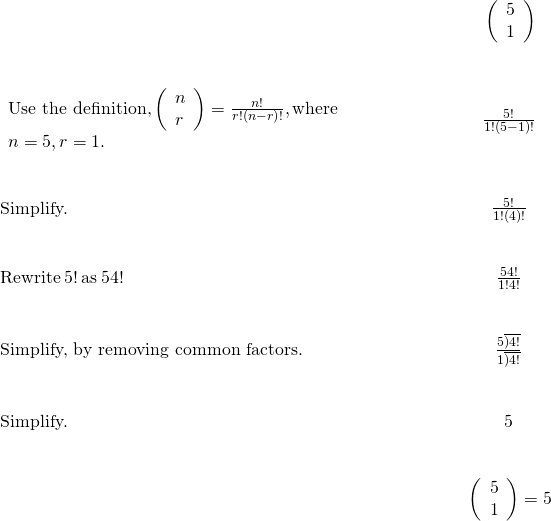
ⓑ
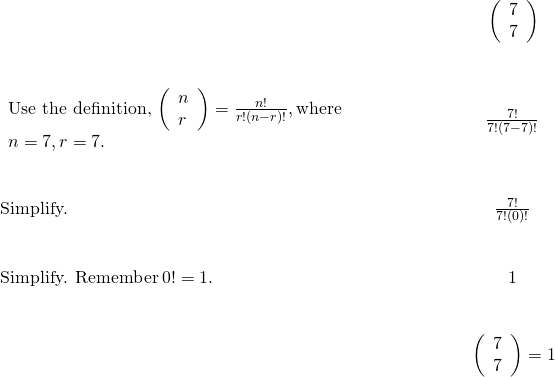
ⓒ
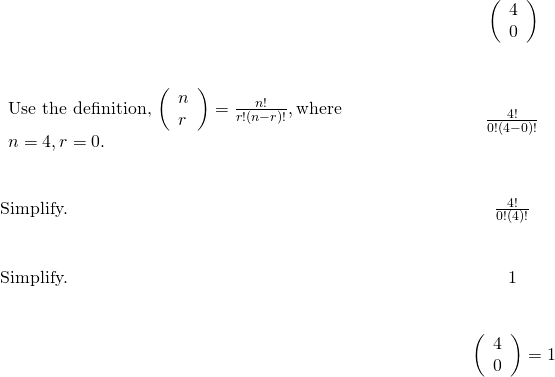
ⓓ

Evaluate each binomial coefficient:
ⓐ![]() ⓑ
ⓑ![]() ⓒ
ⓒ![]() ⓓ
ⓓ![]()
ⓐ 6 ⓑ 1 ⓒ 1 ⓓ 35
Evaluate each binomial coefficient:
ⓐ![]() ⓑ
ⓑ![]() ⓒ
ⓒ![]() ⓓ
ⓓ![]()
ⓐ 2 ⓑ 1 ⓒ 1 ⓓ 6
In the previous example, parts (a), (b), (c) demonstrate some special properties of binomial coefficients.
Use the Binomial Theorem to Expand a Binomial
We are now ready to use the alternate method of expanding binomials. The Binomial Theorem uses the same pattern for the variables, but uses the binomial coefficient for the coefficient of each term.
For any real numbers a and b, and positive integer n,

Use the Binomial Theorem to expand ![]()
We identify the a and b of the pattern.

In our pattern, ![]() and
and ![]()
We use the Binomial Theorem.

Substitute in the values ![]()
![]() and
and ![]()

Simplify the exponents.
Evaluate the coefficients. Remember, ![]()
![]()
![]()
Use the Binomial Theorem to expand ![]()
![]()
![]()
Use the Binomial Theorem to expand ![]()
![]()
![]()
Notice that when we expanded ![]() in the last example, using the Binomial Theorem, we got the same coefficients we would get from using Pascal’s Triangle.
in the last example, using the Binomial Theorem, we got the same coefficients we would get from using Pascal’s Triangle.

The next example, the binomial is a difference. When the binomial is a difference, we must be careful in identifying the values we will use in the pattern.
Use the Binomial Theorem to expand ![]()
We identify the a and b of the pattern.

In our pattern, ![]() and
and ![]()
We use the Binomial Theorem.

Substitute in the values ![]()
![]() and
and ![]()

Simplify the exponents and evaluate the coefficients. Remember,![]()
![]()
![]()
Use the Binomial Theorem to expand ![]()
![]()
![]()
Use the Binomial Theorem to expand ![]()
![]()
![]()
Things can get messy when both terms have a coefficient and a variable.
Use the Binomial Theorem to expand ![]()
We identify the a and b of the pattern.

In our pattern, ![]() and
and ![]()
We use the Binomial Theorem.

Substitute in the values ![]()
![]() and
and ![]()

Simplify the exponents.

Evaluate the coefficients. Remember, ![]()

![]()
![]()
Use the Binomial Theorem to expand ![]()
![]()
![]()
Use the Binomial Theorem to expand ![]()
![]()
![]()
The real beauty of the Binomial Theorem is that it gives a formula for any particular term of the expansion without having to compute the whole sum. Let’s look for a pattern in the Binomial Theorem.

Notice, that in each case the exponent on the b is one less than the number of the term. The ![]() term is the term where the exponent of b is r. So we can use the format of the
term is the term where the exponent of b is r. So we can use the format of the ![]() term to find the value of a specific term.
term to find the value of a specific term.
The ![]() term in the expansion of
term in the expansion of ![]() is
is
Find the fourth term of ![]()
| In our pattern, |
 |
| We are looking for the fourth term. |
|
| Write the formula. |  |
| Substitute in the values, |
 |
 |
 |
| Simplify. |  |
| Simplify. |  |
Find the third term of ![]()
![]()
Find the fifth term of ![]()
![]()
Find the coefficient of the ![]() term of
term of ![]()
| In our pattern, then |
 |
| We are looking for the coefficient of the Since |
|
| Write the formula. |  |
| Substitute in the values, |
 |
 |
 |
| Simplify. |  |
| Simplify. |  |
| Simplify. |  |
| The coefficient of the |
Find the coefficient of the ![]() term of
term of ![]()
7,168
Find the coefficient of the ![]() term of
term of ![]()
280
Access these online resources for additional instruction and practice with sequences.
Key Concepts
- Patterns in the expansion of

- The number of terms is

- The first term is
 and the last term is
and the last term is 
- The exponents on a decrease by one on each term going left to right.
- The exponents on b increase by one on each term going left to right.
- The sum of the exponents on any term is n.
- The number of terms is
- Pascal’s Triangle

- Binomial Coefficient
 : A binomial coefficient
: A binomial coefficient  where r and n are integers with
where r and n are integers with  is defined as
is defined as

We read as “n choose r” or “n taken r at a time”.
as “n choose r” or “n taken r at a time”. - Properties of Binomial Coefficients

- Binomial Theorem: For any real numbers a, b, and positive integer n,

Section Exercises
Practice Makes Perfect
Use Pascal’s Triangle to Expand a Binomial
In the following exercises, expand each binomial using Pascal’s Triangle.
![]()
![]()
![]()
![]()
![]()
![]()
![]()
![]()
![]()
![]()
![]()
![]()
![]()
![]()
![]()
![]()
![]()
![]()
![]()
![]()
![]()
![]()
![]()
![]()
![]()
![]()
![]()
![]()
![]()
![]()
![]()
![]()
![]()
![]()
![]()
Evaluate a Binomial Coefficient
In the following exercises, evaluate.
ⓐ![]() ⓑ
ⓑ![]() ⓒ
ⓒ![]() ⓓ
ⓓ![]()
ⓐ![]() ⓑ
ⓑ![]() ⓒ
ⓒ![]() ⓓ
ⓓ![]()
ⓐ 7 ⓑ 1 ⓒ 1 ⓓ 45
ⓐ![]() ⓑ
ⓑ![]() ⓒ
ⓒ![]() ⓓ
ⓓ![]()
ⓐ![]() ⓑ
ⓑ![]() ⓒ
ⓒ![]() ⓓ
ⓓ![]()
ⓐ 4 ⓑ 1 ⓒ 1 ⓓ 55
Use the Binomial Theorem to Expand a Binomial
In the following exercises, expand each binomial.
![]()
![]()
![]()
![]()
![]()
![]()
![]()
![]()
![]()
![]()
![]()
![]()
![]()
![]()
![]()
![]()
![]()
![]()
![]()
![]()
![]()
![]()
In the following exercises, find the indicated term in the expansion of the binomial.
Sixth term of ![]()
Fifth term of ![]()
![]()
Fourth term of ![]()
Seventh term of ![]()
![]()
In the following exercises, find the coefficient of the indicated term in the expansion of the binomial.
![]() term of
term of ![]()
![]() term of
term of ![]()
112
![]() term of
term of ![]()
![]() term of
term of ![]()
324
![]() term of
term of ![]()
![]() term of
term of ![]()
30,618
Writing Exercises
In your own words explain how to find the rows of the Pascal’s Triangle. Write the first five rows of Pascal’s Triangle.
In your own words, explain the pattern of exponents for each variable in the expansion of.
Answers will vary.
In your own words, explain the difference between ![]() and
and ![]()
In your own words, explain how to find a specific term in the expansion of a binomial without expanding the whole thing. Use an example to help explain.
Answers will vary.
Self Check
ⓐ After completing the exercises, use this checklist to evaluate your mastery of the objectives of this section.

ⓑ On a scale of 1-10, how would you rate your mastery of this section in light of your responses on the checklist? How can you improve this?
Chapter Review Exercises
Sequences
Write the First Few Terms of a Sequence
In the following exercises, write the first five terms of the sequence whose general term is given.
![]()
![]()
![]()
![]()
![]()
![]()
![]()
Find a Formula for the General Term (nth Term) of a Sequence
In the following exercises, find a general term for the sequence whose first five terms are shown.
![]()
![]()
![]()
![]()
![]()
![]()
![]()
![]()
Use Factorial Notation
In the following exercises, using factorial notation, write the first five terms of the sequence whose general term is given.
![]()
![]()
![]()
![]()
Find the Partial Sum
In the following exercises, expand the partial sum and find its value.
![]()
![]()
![]()
![]()
![]()
![]()
![]()
Use Summation Notation to write a Sum
In the following exercises, write each sum using summation notation.
![]()
![]()
![]()
![]()
![]()
Arithmetic Sequences
Determine if a Sequence is Arithmetic
In the following exercises, determine if each sequence is arithmetic, and if so, indicate the common difference.
![]()
![]()
The sequence is arithmetic with common difference ![]()
![]()
In the following exercises, write the first five terms of each arithmetic sequence with the given first term and common difference.
![]() and
and ![]()
![]()
![]() and
and ![]()
![]() and
and ![]()
![]()
Find the General Term (nth Term) of an Arithmetic Sequence
In the following exercises, find the term described using the information provided.
Find the twenty-fifth term of a sequence where the first term is five and the common difference is three.
Find the thirtieth term of a sequence where the first term is 16 and the common difference is ![]()
![]()
Find the seventeenth term of a sequence where the first term is ![]() and the common difference is two.
and the common difference is two.
In the following exercises, find the indicated term and give the formula for the general term.
Find the eighteenth term of a sequence where the fifth term is ![]() and the common difference is seven.
and the common difference is seven.
![]() The general term is
The general term is ![]()
Find the twenty-first term of a sequence where the seventh term is ![]() and the common difference is
and the common difference is ![]()
In the following exercises, find the first term and common difference of the sequence with the given terms. Give the formula for the general term.
The fifth term is 17 and the fourteenth term is 53.
![]()
![]() The general term is
The general term is ![]()
The third term is ![]() and the sixteenth term is
and the sixteenth term is ![]() .
.
Find the Sum of the First n Terms of an Arithmetic Sequence
In the following exercises, find the sum of the first 30 terms of each arithmetic sequence.
![]()
![]()
![]()
In the following exercises, find the sum of the first fifteen terms of the arithmetic sequence whose general term is given.
![]()
![]()
![]()
In the following exercises, find each sum.
![]()
![]()
![]()
![]()
![]()
Geometric Sequences and Series
Determine if a Sequence is Geometric
In the following exercises, determine if the sequence is geometric, and if so, indicate the common ratio.
![]()
![]()
The sequence is not geometric.
![]()
![]()
The sequence is geometric with common ratio ![]()
In the following exercises, write the first five terms of each geometric sequence with the given first term and common ratio.
![]() and
and ![]()
![]() and
and ![]()
![]()
![]() and
and ![]()
Find the General Term (nth Term) of a Geometric Sequence
In the following exercises, find the indicated term of a sequence where the first term and the common ratio is given.
Find ![]() given
given ![]() and
and ![]()
![]()
Find ![]() given
given ![]() and
and ![]()
In the following exercises, find the indicated term of the given sequence. Find the general term of the sequence.
Find ![]() of the sequence,
of the sequence, ![]()
![]() The general term is
The general term is ![]()
Find ![]() of the sequence,
of the sequence, ![]()
Find the Sum of the First n terms of a Geometric Sequence
In the following exercises, find the sum of the first fifteen terms of each geometric sequence.
![]()
5,460
![]()
![]()
![]()
In the following exercises, find the sum
![]()
![]()
![]()
Find the Sum of an Infinite Geometric Series
In the following exercises, find the sum of each infinite geometric series.
![]()
![]()
![]()
In the following exercises, write each repeating decimal as a fraction.
![]()
![]()
![]()
Apply Geometric Sequences and Series in the Real World
In the following exercises, solve the problem.
What is the total effect on the economy of a government tax rebate of ![]() to each household in order to stimulate the economy if each household will spend
to each household in order to stimulate the economy if each household will spend ![]() of the rebate in goods and services?
of the rebate in goods and services?
Adam just got his first full-time job after graduating from high school at age 17. He decided to invest ![]() per month in an IRA (an annuity). The interest on the annuity is
per month in an IRA (an annuity). The interest on the annuity is ![]() which is compounded monthly. How much will be in Adam’s account when he retires at his sixty-seventh birthday?
which is compounded monthly. How much will be in Adam’s account when he retires at his sixty-seventh birthday?
![]()
Binomial Theorem
Use Pascal’s Triangle to Expand a Binomial
In the following exercises, expand each binomial using Pascal’s Triangle.
![]()
![]()
![]()
![]()
![]()
![]()
![]()
![]()
Evaluate a Binomial Coefficient
In the following exercises, evaluate.
ⓐ![]()
ⓑ![]()
ⓒ![]()
ⓓ![]()
ⓐ 11 ⓑ 1 ⓒ 1 ⓓ 56
ⓐ![]()
ⓑ![]()
ⓒ![]()
ⓓ![]()
ⓐ![]()
ⓑ![]()
ⓒ![]()
ⓓ![]()
ⓐ 1 ⓑ 1 ⓒ 1 ⓓ 55
Use the Binomial Theorem to Expand a Binomial
In the following exercises, expand each binomial, using the Binomial Theorem.
![]()
![]()
![]()
![]()
![]()
![]()
![]()
![]()
![]()
In the following exercises, find the indicated term in the expansion of the binomial.
Seventh term of ![]()
![]()
Third term of ![]()
In the following exercises, find the coefficient of the indicated term in the expansion of the binomial.
![]() term of
term of ![]()
135
![]() term of
term of ![]()
![]() term of
term of ![]()
280
Practice Test
In the following exercises, write the first five terms of the sequence whose general term is given.
![]()
![]()
![]()
Find a general term for the sequence, ![]()
Expand the partial sum and find its value. ![]()
![]()
Write the following using summation notation. ![]()
Write the first five terms of the arithmetic sequence with the given first term and common difference. ![]() and
and ![]()
![]()
Find the twentieth term of an arithmetic sequence where the first term is two and the common difference is ![]()
Find the twenty-third term of an arithmetic sequence whose seventh term is ![]() and common difference is three. Then find a formula for the general term.
and common difference is three. Then find a formula for the general term.
![]() The general term is
The general term is ![]()
Find the first term and common difference of an arithmetic sequence whose ninth term is ![]() and the sixteenth term is
and the sixteenth term is ![]() Then find a formula for the general term.
Then find a formula for the general term.
Find the sum of the first 25 terms of the arithmetic sequence, ![]()
![]()
Find the sum of the first 50 terms of the arithmetic sequence whose general term is ![]()
Find the sum. ![]()
![]()
In the following exercises, determine if the sequence is arithmetic, geometric, or neither. If arithmetic, then find the common difference. If geometric, then find the common ratio.
![]()
![]()
The sequence is geometric with common ratio ![]()
Write the first five terms of the geometric sequence with the given first term and common ratio. ![]() and
and ![]()
In the geometric sequence whose first term and common ratio are ![]() and
and ![]() find
find ![]()
![]()
Find ![]() of the geometric sequence,
of the geometric sequence, ![]() Then find a formula for the general term.
Then find a formula for the general term.
Find the sum of the first thirteen terms of the geometric sequence, ![]()
![]()
In the following exercises, find the sum.
![]()
![]()
![]()
Write the repeating decimal as a fraction. ![]()
Dave just got his first full-time job after graduating from high school at age 18. He decided to invest ?450 per month in an IRA (an annuity). The interest on the annuity is 6% which is compounded monthly. How much will be in Adam’s account when he retires at his sixty-fifth birthday?
![]()
Expand the binomial using Pascal’s Triangle. ![]()
Evaluate each binomial coefficient. ⓐ ![]()
ⓑ ![]() ⓒ
ⓒ ![]() ⓓ
ⓓ ![]()
ⓐ 8 ⓑ 1 ⓒ 1 ⓓ 210
Expand the binomial using the Binomial Theorem. ![]()

